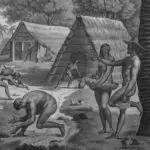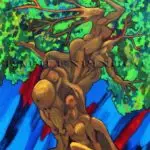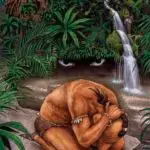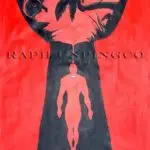Taotaomo'na




Table of Contents
Share This
First people
Taotaomo’na, the people of before, refers to ancestral spirits that inhabited the earth along with the living. Ancient CHamorus/Chamorros believed the world around them was full of spirits who provided both daily protection and assistance in their tasks, but also created dangers and problems. Guma’ siha (houses) were built, families were raised and tinanom siha (crops) were harvested and planted through harmonious cooperation between CHamorus and the aniti (spirits) of their ancestors.
The connection between CHamorus and these spirits has changed over time, primarily due to cultural changes that came about from Spanish colonization and Christianization. Slowly over time, these spirits have changed from the ante of ancestors to the wily ghosts, devils and demons that play tricks or cause harm to CHamorus today. Taotaomo’na can be defined in three different ways, each definition depending upon the amount of familiarity or distance between these spirits and living CHamorus.
Our elders and family
Taotaomo’na as i mañainå-ta yan familiå-ta
Taotaomo’na is therefore a term which could refer in general to all the spirits of CHamoru ancestors, to all of those who have come before. In this definition, these spirits played a huge role in the daily life of CHamorus offering assistance and protection with all sorts of daily tasks. These spirits were treated as members of the family and were referred to be name or through terms of endearment. Given this intimate arrangement, these sorts of taotaomo’na were thought to dwell on the tåno’ (land) of their descendants or thought to inhabit ancestral skulls or maranan uchan which CHamorus kept in baskets in the rafters of their guma’saga’ (homes).
These skulls would be offered nenkanno’ (food) and gimen (drink) at meals and offered the best catch after men returned from fishing. In all things they would be honored and thanked for their role in keeping the family safe, prosperous and strong. Ceremonies were held amongst families and sengsong siha (villages) to celebrate their spirits and show their respect to them by making offerings of food and artifacts, as well as competitions of physical and mental skill in their honor. One of the most important ways in keeping favor with one’s ancestral spirits would be to maintain one’s kinship ties and obligations and ensure harmonious relations among members of a clan. An individual not meeting these obligations and behaving taimamåhlao (without shame) was one of the surest ways to displease an ancestral spirit and cause them to withdraw their protection from the family.
These spirits were invoked and called upon in times of great danger. They were needed to defend against any evil or malevolent spirits that inhabited the halomtano’ (jungle) and liyang siha (caves), as well as any violence the ante of rival clans might cause. Even in times of life-threatening danger or crisis, it would be these spirits that CHamorus would call to for aid. They would cry out to their favored spirits by name imploring that “if they have ever loved their family, then they would help right now!”
Those who came before
Taotaomo’na as i manmofo’nå-ta
Taotaomo’na also refers to the ante of ancestors whom CHamorus could no longer connect themselves to through genealogy. These were remote spirits, which could not be easily counted upon for help as if members of a clan, but instead had to communicate primarily through intermediaries such as makanas. Makanas were “spirits counselors” or “medicine men” who could be bartered with or compensated to seek the counsel or assistance of spirits. Makanas would beseech the dead on behalf of the living to bring stunning victories in battle, good luck in harvesting or fishing. If things were amiss in a family, and nothing but tragedy was befalling them, they could enlist the aid of a makana to find out from the taotaomo’na what offense they had made or sins they had committed to deserve this treatment or why their ancestral spirits had abandoned them. A makana could also be enlisted in order to turn spirits against a rival or enemy clan.
Over time the role of makanas slowly became what CHamorus today refer to as suruhanus and suruhanas, who would also be able to communicate with taotaomo’na, but primarily in the service of healing the manmalångu (sick). Suruhanus possess a vast amount of knowledge of tinanom (plants) on Guam which can be used to make different forms of amot (medicine). In addition, suruhanus can ask the taotaomo’na to help identify the causes of different illnesses, and if there are spirits involved in making their patient ill, they can also help communicate how the conflict can be resolved and amends made.
Some CHamorus had privileged relationships to taotaomo’na. These people were usually referred to as gaitaotao or gaiga’chong. For these people, a taotaomo’na was their ga’chong (friend and companion) and with them at all times, helping them and giving them the appearance of having super-human skills or being sen metgot (very strong).
Since the names or the genealogy of these spirits was not always known, they could not be referred to in familiar or endearing ways. They were instead to be spoken to with great respect and often called guello yan guella (grandfather and grandmother). When passing through the tano’ (land) where particular spirits resided, it was crucial that the passer-by call to them first in this sort of respectful manner, as great elders, and then request permission to pass through their land.
Asking permission
The following is said to ask permission to pass:
Guella yan Guello, dispensa ham låo Kåo siña ham manmaloffan yan manmanbisita gi tano miyu sa’ yanggen un bisita i tano’må mi faloffan-ha’ sin un famaisin.
Grandmother and grandfather, excuse us. May we walk through and visit your land and when you come to our land we will welcome you to do the same.
The following is said before relieving yourself in the jungle:
Guello yan Guella kao siña u usa i kemon guini ya agin matu hamyu gi tano-hu sinen isa lokkue.
Grandmother and Grandfather may I use the restroom here? When you come to my land you may do the same.
Ancient CHamoru history provides the names of a few of these remote ancestral spirits, whom CHamorus knew they were related to, but did not treat with the same intimacy that they did their relatives that had recently passed away. Fu’una and Puntan, the brother and sister who created Guam in the story of CHamoru origins, could be considered the fine’nina na taotao, (first people) and therefore the first taotaomo’na. Around the time of the Spanish colonization of Guam, there were notoriously strong taotaomo’na which CHamorus revered and feared around Guam.
Gamson (octopus), was a taotaomo’na who lived in Pågo Bay near a latte site. He was known as an incredibly strong spirit who could catch five guihan (fish) at once, with only his kannai (hands) and kamyo (grate) coconut by squeezing its shell until it came spraying out. Gatos (100) was a taotaomo’na who was known for his large penis. He would travel with other spirits which served as his soldiers, who would use Gatos’ penis when crossing rivers. If you entered into Gatos’ territory without permission and were to disrespect him by urinating there, he would touch his penis to you, and you would be unable to me’me’ (urinate) or masinek (defecate).
Anufat was a big ugly taotaomo’na. He had large fangs and nails. On the side of his body was a huge gaping wound, out of which grew a galak dangkulu (a type of large fern).
Those who are evil and cruel
Taotaomo’na as i mantailayi (manailayi) yan manmala
Lastly, in the definition which matches closely to the way CHamorus think of them today, taotaomo’na are mananiti or aniti, pesky, troublesome and sometimes evil spirits. This definition is heavily influenced by Spanish Catholicism and does not view taotaomo’na as the spirits of CHamoru ancestors, except perhaps as pagan, evil spirits of their ancient uncivilized past. In this version taotaomo’na are not gracious, giving or helpful, but are instead notorious for hurting people and playing tricks on the living. These taotaomo’na are not to be trusted at all, but rather feared.
Duhendes, a Spanish word, are one such type of taotaomo’na. They are small, dwarf-like people, who go naked or wear clothes made of hagon siha (leaves). They are most well known for luring unsuspecting children into the halom tano’ (jungle) by taking the shape of a chichirika (a red fantail bird), singing songs to them, or by offering them gifts or treats. Once captured a child would be shrunk down to such a small size that those looking for them would easily step over them or walk right by them completely unawares. When a child is eventually found they usually suffer from chetnot manman, meaning they will stare into space with a blank and empty look. To fix this, they will have to be taken to a suruhånu or a pale’ (priest).
Taotaomo’na would often haunt or be associated with certain areas or objects, such as the halom tano’, latte sites, and trongkon nunu (banyan trees). Those who entered these spaces without proper permission, or who behaved tai respetu (without respect) once in them would be subject to the anger and tricks of the spirits who called that area home.
In some instances a violent and tragic death will forever link a spirit to the site of its death.
These sorts of taotaomo’na are able to take different human, animal and material forms when they interact with the living. They can appear as binådu (deer), ayuyu (coconut crabs), ga’lågu (dogs), and even paluma (birds). One famous taotaomo’na is the Utak or Itak which is a large white-tailed bird with a shrill call, which is heard throughout the village each time an unmarried girl becomes mapotge’ (pregnant).
Taotaomo’na also appeared as human or in close human form, sometimes taking the appearance of familiar people such as relatives, but other times appearing tai ulu’ (without head) or tai mata’ (without face). They sometimes have an alluring smell akin to fadang (frederico palm) or lime or ilangilang (a fragrant tree). Other times the smell can be repulsive like basula (trash) or take’ (feces). When speaking it can appear as ngokngok or incomprehensible speech, or even hissing or the sound of branches being snapped and rubbed together. In other instances their speech is simply older and archaic CHamoru.
Taotaomo’na have the ability to cause the living to become terribly ill. They do so by de’on (pinching), akka’ (biting) or pacha’ (touching). If a taotaomo’na wishes to make you ill it can make you become feverishly sick (chetnot maipe’), turn you into a zombie and put you into a deep trance (chetnot manman) or cause parts of your body to swell up. When a person has been touched by a taotaomo’na with the intent that they become ill, finger, nail or teeth marks may appear on a person’s body, in colors such as yellow, brown or purple. Some taotaomo’na have control over wind, rain, lighting and thunder. These are called lamlamtaotao and can shape and change the weather to incite fear in the living.
As this definition of taotaomo’na is something to be feared and resisted, CHamorus have compiled practices of how to repel these spirits and keep them away because they cannot stand to come into contact with them. Some colors are said to repel taotaomo’na while others are said to attract them, but this depends primarily on the particular affinities of the spirits involved. Salt is thought to weaken taotaomo’na, which is one reason why they are found primarily inland in the halom tano’ (jungle) and not along the coast near i tasi (the sea).
In the early 20th century, a CHamoru man who was gaitaotao (possessed) and unbeatable in wrestling, was supposedly vanquished after his opponent sprinkled salt around the ring before their match. Money, sacred religious objects and even the guma’ yu’us (church) itself are thought to be objects or places which taotaomo’na cannot touch or stand to be near.
For further reading
Cunningham, Lawrence J. Ancient Chamorro Society. Honolulu: Bess Press, 1992.
Driver, Marjorie G. The Account of Fray Juan Pobre’s Residence in the Marianas, 1602. MARC Miscellaneous Series No. 8. Mangilao: Micronesian Area Research Center, University of Guam, 1993.
Flood, Bo. Marianas Islands Legends: Myth and Magic. Honolulu: Bess Press, 2001.
Freycinet, Louis Claude Desaulses de. An Account of the Corvette L’Uraine’s Sojourn at the Mariana Islands, 1819. Translated by Glynn Barratt. Saipan: Commonwealth of the Northern Mariana Islands Division of Historic Preservation, 2003.
McMakin, Patrick D. “The Suruhanos: Traditional Curers on the Island of Guam.” Micronesica 14, no. 1 (1978): 13-67.
Mitchell, Roger E. “Ancestral Spirits and Hitchhiking Ghosts: Syncretism on Guam.” Midwestern Journal of Language and Folklore 2, no. 2 (1976): 45-55.
Russell, Scott. Tiempon I Manmofo’na: Ancient Chamorro Culture and History of the Northern Mariana Islands. Saipan: Commonwealth of the Northern Mariana Islands Division of Historic Preservation, 1998.
Souder-Jaffery, Laura Marie Torres. Daughters of the Island: Contemporary Chamorro Women Organizers on Guam. 2nd edition. MARC Monograph Series No. 1. Mangilao: Micronesian Area Research Center, University of Guam, 1992.
Thompson, Laura M. Guam and Its People. With a Village Journal by Jesus C. Barcinas. 3rd ed. New Jersey: Princeton University Press, 1947.
Topping, Donald M., Pedro M. Ogo, and Bernardita C. Dungca. Chamorro-English Dictionary. Honolulu: University of Hawai’i Press, 1975.
